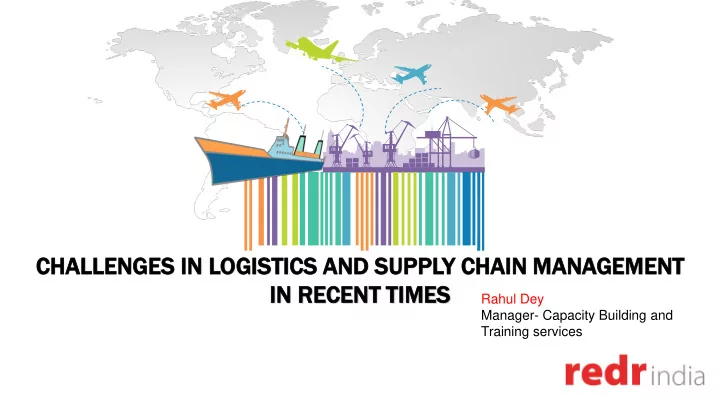

CHAL ALLEN LENGES GES IN IN LOGIS GISTICS TICS AND SUP UPPL PLY Y CHAIN AIN MANAGEM GEMENT NT IN IN REC ECEN ENT T TIMES IMES Rahul Dey Manager- Capacity Building and Training services
What are we going to talk about? WHAT IS LOGISTICS AND SUPPLY 01 CHAIN MANAGEMENT? 02 CHALLENGES 03 WHAT CAN WE DO FOR THE FUTURE?
WHA HAT T IS IS LOGISTICS GISTICS AND SUP UPPL PLY Y CHAIN HAIN MANAGEMENT? GEMENT?
DE DEFININ FINING G LOG OGISTICS ISTICS • Logistics is the process of planning, implementing, co-ordinating, and controlling the flow and storage of goods, services, and related information so as to deliver: All the RIGHT COMMODITIES To the RIGHT PLACES At the RIGHT TIME In the RIGHT QUANTITY Of the RIGHT QUALITY At the RIGHT PRICE A B
Suppliers Transport Central Warehouse Transport Local Warehouse Community Relief Source: IFRC
Planning Effectiveness Sourcing Elements Logistics Efficiency INFORMATION
HU HUMAN ANIT ITARIAN ARIAN LOGISTIC STICS S AND ND SUPP PPLY Y CHA HAIN N MANA NAGEMENT GEMENT $ $ $ Procurement Program Staff Vendor Field Program $ Transit Warehouse Local Instituions Distribution Donor Warehouse Pre-positioned Stock Beneficiaries Monitoring and Evaluation Trucks Cars Asset Management Fleet Management Program Staff
CHAL HALLENG LENGES ES No supply shock in sense of availability, but there is starting to be a supply stock in terms of logistics of movement.
Governments are battling to figure out the right trade response to the COVID-19 pandemic, amidst the escalating economic turmoil. Initial responses show the difficulties and the risk of getting things wrong. An understandable response of locking everything down to slow the spread of disease and keep control of equipment also limits the movement of essential workers and stops critical supply chains from functioning effectively. Over 50 countries were restricting the export of certain medical supplies by mid- March, and travel barriers are in place worldwide – in many cases even blocking movement between sub-national regions. Measures away from the border like the closure of hotels mean supply-chain workers – from research scientists to engineers to cargo pilots – are constrained from operating effectively.
DIF DIFFI FICUL CULTIES SO SOUR URCIN CING FOR, AND PROC OCURING GOODS DS AND AND SERVICES CES You could find it hard to secure external • partnerships due to travel restrictions. This could hamper your discovery of new • business opportunities. LABOUR SHOR ORTAGES Your workers might be unable to reach their factories • or workplaces due to restrictions such as travel bans, home quarantines, vehicle checks and sealed residential compounds. This necessitates work reallocations and may hinder • productivity. DE DELAYS OR OR SHORT SHORTAGE GES IN IN OBT BTAI AINING NING NECESSAR SSARY RAW MATERIALS LS Productivity and output of your factories may • fall due to shortages of raw parts. Your production can be delayed as key • resources are being held up at warehouses, seaports and airports.
NEW REGULATOR NEW ORY REQUIR IREME MENTS • You may need to implement public health safeguards to resume production. You can expect delays in resuming • production if you need to apply for permits and wait for approval. STOP OPPAGES IN IN PRODU DUCT CTION ON You might have to halt your production if your • suppliers are unable to fulfil contractual obligations due to the outbreak. You may not be able to enforce contracts if • suppliers invoke force majeure clauses for legal defence. STOR ORAGES IN IN IN INVENTOR ORY Your inventory items could fall short or run out • due to failures in delivery, and you are unable to meet consumer demand. Your customers may cancel their orders and you • could incur losses.
WHA HAT T CA CAN N WE E DO FOR THE HE FUTURE? UTURE?
WH WHAT T WE WE CAN CAN LE LEARN? ARN? The COVID-19 pandemic is Solutions include data sharing, raising questions about risks trusted networks and multi- in supply chains. stakeholder input to legislation Past disruptions offer lessons for the current crisis
Digital Focus: Preparedness Focus: - Digital twins - Pre-allocation of resources - Data analytics and AI - Emergency distribution planning - Digital manufacturing - Product diversification and substitution - Blockchain Sustainability Focus: Adaptation Focus: - Consideration of supply chain OPERA OP RATI TIONS AND SUPPLY Y - Re-allocations of supply demand ecosystems CHAI AIN MAN ANAGEM GEMENT ENT UNDER DER - Flexible production technologies for - Viability analysis EPIDEMIC IDEMIC OU OUTBRE REAKS AKS AND D meeting the society needs under PANDE NDEMICS MICS - Intertwined supply networks pandemics (e.g. masks and ventilators - Humanitarian logistics Recovery Focus: Ripple Effect Focus: - Integral recovery of workforce, - Control of disruption propagations capacities and logistics infrastructures - Modelling of pandemic scenarios and supply chain structural dynamics - Forecasting of pandemic propagation and ramp-up decisions
Recommend
More recommend